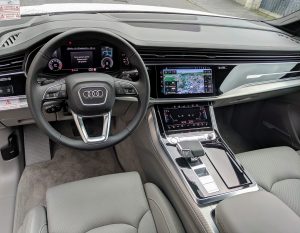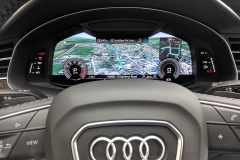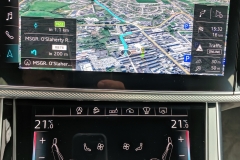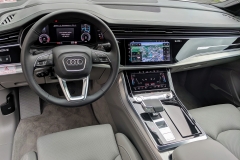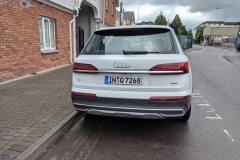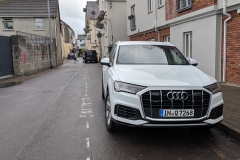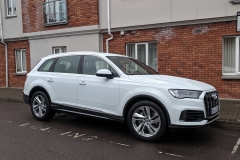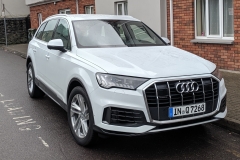2020 Audi Q7 first test drive
Audi has released a significantly revised version of its full-sized SUV, the new 2020 Audi Q7.
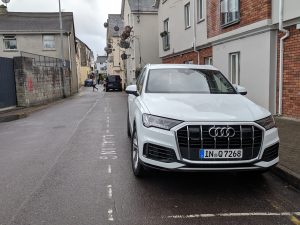 The second generation Q7 debuted in 2015, bringing with it significantly improved cabin technology and engineering features, such as optional 4 wheel steering and a hybrid option in certain markets. With this latest version of the Q7, Audi engineers sharpened their pencils and delivered what is undoubtedly the best Q7 to date and may be the most advanced SUV on the market today.
The second generation Q7 debuted in 2015, bringing with it significantly improved cabin technology and engineering features, such as optional 4 wheel steering and a hybrid option in certain markets. With this latest version of the Q7, Audi engineers sharpened their pencils and delivered what is undoubtedly the best Q7 to date and may be the most advanced SUV on the market today.
While the wheelbase remains unchanged, designers have lengthened the Q7 by 11mm. Width and overall height are unchanged. Visually the new Q7 stands apart from earlier models with a revised front single frame grille, that is now wider and lower. Framing the new grille are new multi-faceted headlights and larger air intake ducts below them. A colour-keyed front spoiler adds a sporting element and ties into muscular rocker panels that now underline the doors.
Canadian buyers with be able to order Audi’s pioneering laser powered headlights in the 2020 Q7. The full Matrix laser system available in Europe still awaits government approval in North America.
Another design change are the massive 21 inch wheels that will also feature colour keyed sections to match accent trims on the vehicle.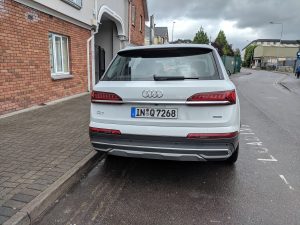
At the rear, a new lower defuser better integrates the exhaust pipes and gives the Q7’s rear clip a more streamlined appearance. The rear taillights have also been revised with a new LED pattern, to make this model easily identifiable from the current model.
The Q7 has always been billed as a 7-seater SUV but that 3rd row is optional. The standard second row seating comes with adjustable legroom and recline. The 3rd row of seating offers electronically collapsible seat backs for additional storage. A power tailgate is standard on all Q7’s. In 5 seat format, the 2020 Audi Q7 offers between 865 and 2,050 litres of storage.
The 2020 Audi Q7 cabin has been updated also. The class-leading MMI system integrates vehicle controls, comfort and climate settings into two dash mounted LCD screens, as well as the LCD virtual cockpit driver information center behind the steering wheel. The MMI system now features a normal command voice control system that worked flawlessly on our test.
Connectivity on the test vehicles we were shown was impressive. However many of the systems available in Europe aren’t supported with our aging infrastructure in North America.
According to Audi, the 2020 Q7 offers… LTE Advanced, a Wi-Fi hotspot, natural voice control, traffic information online, navigation with Google Earth, hybrid radio, the cloud-based Amazon voice service Alexa, which is integrated into the MMI operating system, Car-to-X service traffic light information- allows the vehicle to receive information from the central traffic light computer to match the next green-light phase as well as the remaining time until the next green-light phase if the driver is already waiting at a red light. The system thus contributes to a predictive and efficient driving style and facilitates a steady flow of traffic. The adaptive cruise assist, which combines the functions of adaptive speed assist, traffic jam assist and active lane assist, in combination with efficiency assist, it brakes and accelerates the Audi Q7 in anticipation of the conditions ahead. The emergency assist is also new: If the driver is inactive, the system brings the car to a stop and initiates protective and rescue measures.
Canadians will have a choice of two engines to power their Q7’s. The base power-plant is the latest version of the 2.0L TFSI engine and a larger 3.0L TFSI engine, now turbocharged instead of supercharged as installed on earlier models. The V6 engine produces 335hp and 369 lb-ft of torque. The move increases output from the engine in both categories mentioned. Audi’s famed Quattro all-wheel-drive system is standard on the Q7. One feature included to reduce fuel economy is the adoption of the 48V mild hybrid system, first introduced and installed in the range topping A8 sedan when the latest model was introduced last year. The system relies on a belt driven starter, alternator, generator, which feeds power to a lithium-ion battery. When called upon the battery will allow the vehicle to “coast” with the engine deactivated. The battery will power onboard systems at speeds between 55 and 160 kms /hr for up to 40 seconds. The system can reportedly reduce fuel consumption by as much as 0.7 litres per 100 kms.
A more tangible effect of the 48V electrical system is the ability to power a new optional active anti-roll stabilization system, previous unavailable due to limitations caused by a 12V electrical system.
As mentioned earlier, the new Audi Q7 comes with 4 wheel steering that will have the rear wheels steer counter to the front wheel input at slower speeds, but will steer the rear wheels parallel to the fronts at higher speeds to provide stability. Another boost to the Q7 handling is the increase in steering reaction. Turning the steering wheel from full lock one way to the other now takes 2.4 turns as opposed to 2.9 rotations earlier.
Buyers will also have the choice of a standard hydraulic damper suspension or two adaptive air suspensions, one branded as a sport suspension. This option has the Q7 sitting 15 mm lower than the other two offerings. Either adaptive suspension will allow for 40mm of travel upward or 50mm lower, for a combined range of 90mm.
We were able to experience all that either of these adaptive air suspensions and the anti-roll system had to offer on our visit to Ireland. Our test drive took us around the famed Ring of Kerry, a serpentine ribbon of pavement hugging the incredibly scenic Atlantic coast and meandering back inland through mountains and past lush hills and stunning lakes.
As this was summer and thus peak tourist season we didn’t expect much in the way of spirited driving, however leaving on our adventure early put us ahead of most of the tour buses. However, rounding a blind turn and finding a large bus or transport truck in our way, tested the handling and braking of the Q7.
The car-like nature of the large SUV was truly inspiring. The active suspension, anti-roll system and refined Quattro AWD system, were impressive in real world driving.
Hopefully much of the technology showcased on our drive will make it to Canadian showrooms when the 2020 Audi Q7 goes on sale in the first quarter of 2020. Expect a similar three trim package offering (Komfort, Progressiv, and Technik) with prices to be confirmed closer to introduction.
Copyright © Auto Reviews Online 2016 | Privacy & Terms of Use | info@autoreviewsonline.com | Website by Brolly Media

